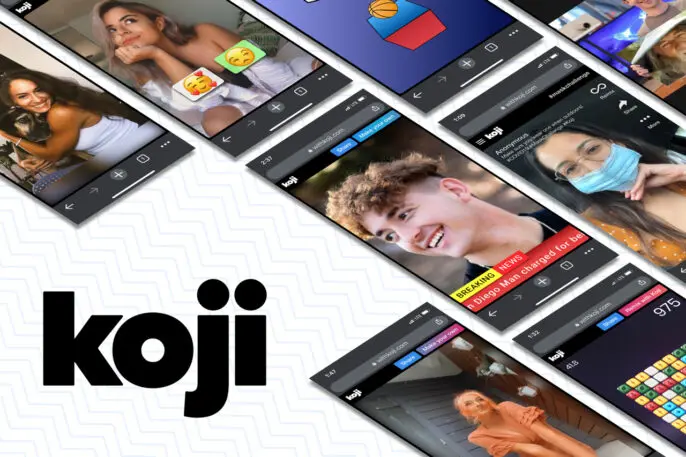While most social platforms have found new ways to democratize content creation, TikTok represented a paradigm shift in how content can be repurposed.
TikTok’s popularity largely hinges on how users remix existing video and audio clips, resulting in what’s been referred to as the “content network effect,” i.e., content gaining value the more users add to it.
And that value has been exponential: The TikTok app has been downloaded more than 2 billion times since launching in 2016, and ByteDance, the parent company of TikTok, reportedly has a private valuation between $105 billion and $110 billion, which, if true, would make it the most valuable startup in the world.
But just as one company or service seems invincible, competitors arise; and ex-Googler Dmitry Shapiro thinks he’s landed on the next evolution of remix culture with Koji.
https://www.youtube.com/watch?v=tycuTklbvFI
Koji is a platform that aims to democratize interactivity by allowing users to customize memes, selfies, and web games using GIFs, audio clips, and so forth, based on the various templates created by independent developers. For example, a developer can upload a basic zombie shooter game that users remix by changing the background, characters, music, and more.
“Starting from something that already exists and customizing it is actually a whole new type of creativity,” says Shapiro, who serves as Koji’s CEO. “We believe the next phase is interactive.”
So do a slew of Koji’s high-profile investors, including Michael Eisner, former CEO of Disney; Richard Gingras, vice president of news at Google; and Mark Pincus, founder of Zynga. Koji has spent a year in beta fueled by a $10 million series A round led by the VC firm Galaxy Interactive.
Now Shaprio is ready to take Koji to the masses.
In addition to being a new content-creation tool (or at minimum, a new way to kill time on the internet), Koji also could become a powerful marketing tool for brands and a formidable player in the casual gaming space—if it can find its footing.
Koji’s mission is to push the evolution of remix culture by democratizing interactivity. But is what it’s offering as that evolutionary leap missing a step?
Making code for all
The idea for Koji started with 25-year-old developer Sean Thielen, whom Shapiro began mentoring when Thielen was a college student at Chapman University in Orange, California.
“He was the most exceptional developer that I had ever personally encountered—and that’s saying a lot,” Shapiro says. “This kid was a lit major, never taken a computer class in his life. Sean is one of these one-in-a-million developers.”
Thielen had an idea for democratizing code that enticed Shapiro to leave his product manager position at Google to start a San Diego-based software development company named GoMeta alongside Thielen in 2016.
Their first project: Koji.

“Sean’s analogy for this is, if creators were interior decorators, it would be as if they were forced to choose the gauge of wire for the electrical main when all they care about is styling the living room,” says Richard Kim, partner at Galaxy Interactive. “If you want to build an interactive app today, you have to think about authentication module, user account, profiles, navigation, storage, payments, etc. It’s just absurd.”
“That’s why we think Koji is so fascinating,” adds Sam Englebardt, managing partner at Galaxy Interactive. “We’ve seen it in TikTok—and that’s an amazing platform—but Koji can really execute and deliver a level of interactivity and sophistication in the technology.”
Ease of use is certainly part of Koji’s appeal, and microtransactions aren’t far behind.
Users can leave tips for developers, but Shapiro says there will soon be the capability for developers to charge upfront for their templates. Both users and developers can also receive tips for custom asset packs (images, GIFs, and audio clips) for people to use in remixing their Kojis.
Given how discerning online creators have become in receiving compensation (or at the very least, credit) for their work, adding microtransaction features is a solid move. Especially in the context of remix culture, where the derivative nature of the content can make it difficult to trace the source.
For Shapiro, though, microtransactions aren’t leading the conversation at Koji.
“When I’m talking to business people, I call this a marketplace, but that’s not how I think about it. That’s not how Sean thinks about it,” Shapiro says. “It’s this tool that gives people superpowers without writing any code. It’s a community of developers. It’s a community of creative people.”
And where there’s a community creating engaging digital content, brands are sure to follow.
A moldy muse for brands
Koji could be a valuable asset to a brand’s marketing toolkit: Gonzo internet ephemera meets tangible engagement.
Take Burger King, for example.
Back in February, Burger King released its “Moldy Whopper” campaign promoting that it would no longer use artificial preservatives in its food—and it drew mixed reviews. While some applauded the campaign’s message that real food rots, others couldn’t stomach the glamour shots of a furry, green hamburger.
Koji users, though, began creating games in response to the campaign. According to Koji, the first game Burger King retweeted received 30,000 plays in less than 48 hours with an average of two minutes of engagement.
Other brands including Google, Bazooka chewing gum, and even Singapore’s Ministry of Education have also engaged with Koji.
“We went from fan art to fan fiction, and now because of this, you get fan games,” Shapiro says. “If I was a social media manager inside of a brand, I would be saying, ‘I want the world to show their creativity and create things about Oreo cookies. Here’s our asset pack—go and make amazing things and share them.'”
“They’ve spent a lot of time on this data and analytics layer that allows them to quantify the value of engagement on every Koji,” Kim says. “One of TikTok’s biggest revenue streams is its sponsored hashtag. So if Koji can show all of that data in a compelling way, its life is going to be a lot easier with these brand conversations.”

Keeping it (hyper)casual
In addition to leveraging the marketing space, Koji has an opportunity to dig its heels into hypercasual gaming (aka “tap to play” games), which reportedly pulled in upward of $2.5 billion in revenue last year.
In fact, gaming is how Koji cut its teeth in its beginning, with the bulk of templates leaning toward those addictive web games.
“While I loved the underlying infrastructure of Koji, I ultimately don’t think Koji can succeed if it’s a tool for creating somewhat mediocre hypercasual games,” Kim says. “So what I asked these guys is what do they think is the foundational building block for interactive expression? And by that, I mean, I don’t go to Koji saying, I’m going to express how angry I am about XYZ by developing a bubble shooter game. The thing that they’ve done a really good job of in the last two months has been narrowing their focus on that question and building the platform in a way where on day one, they’re expecting people to come to the website to iterate, to play, and to learn.”
It’s a fair critique given Koji’s larger mission of democratizing digital media. But, after clicking around on Koji’s site, one has to wonder if they would have been better off zeroing in on—and refining—casual games. Out of the current options to remix memes, selfies, or games, the latter has by far the most satisfying outcome, in that you’re creating something that will have a high level of engagement (points scored, levels achieved, and the like).
Creating selfies and memes on Koji don’t reach that same level of interactive impact. The best feature you can add on memes are just audio clips. A few of the selfie templates, like tapping the screen to flip a picture, could be a fun spin on Throwback Thursday or some internet challenge—but, as with the memes, the interactivity is quite limited.
Of course, more sophisticated templates and features could be on the way. For now, though, Koji does feel a bit stretched thin with the scale of interactive fun clearly tilted in gaming’s favor.
That said, Koji’s lacking selfie and meme templates aren’t its only concern.
Shapiro pushing Koji as a community is a little hard to back up given the lack of proper infrastructure to facilitate said community on the platform itself.
Deeter from the YouTube channel DeeterPlays has been using Koji for months as a new way to connect with his followers and subscribers through fan-made Koji game contests and an asset pack he encourages them to use with him and each other.
“We can make memes and jokes about something silly that I did in a live stream or in a video, or something funny that somebody else did,” Deeter says. “It brings the community, not just even closer to me, but closer to each other as well.”
But all of that connectedness is happening on other platforms—not Koji.
At the moment, there’s a “Community” tab on Koji’s site that takes you to some of its more popular users. But there’s no way to follow them, comment, or DM. It’s just a grid of their Kojis on their pages.
“If there was a way within the platform to build an audience and gain subscribers—people are used to a certain layout like YouTube and like Facebook,” Deeter says. “You don’t want it to turn into those, but I think adding to the social media within the platform would be useful.”
In fairness, while laying out Koji point by point, Shapiro did caution not to pay much attention to everything he said that day.
“That’s the beginnings of evolution. It’s the cat videos on YouTube, or Pez dispensers on eBay, or books on Amazon. This is our version of that,” Shapiro says of Koji’s current iteration. “All that stuff I just showed you—that’s not the big idea. The big idea is much bigger than that.”
Recognize your brand’s excellence by applying to this year’s Brands That Matter Awards before the early-rate deadline, May 3.
